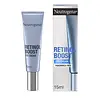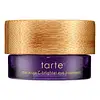What's inside
What's inside
 Key Ingredients
Key Ingredients

 Benefits
Benefits

 Concerns
Concerns

 Ingredients Side-by-side
Ingredients Side-by-side

Water
Skin ConditioningPentaerythrityl Tetraethylhexanoate
EmollientDimethicone
EmollientGlycerin
HumectantPPG-15 Stearyl Ether
EmollientStearyl Alcohol
EmollientCetearyl Alcohol
EmollientButylene Glycol
HumectantCeteareth-20
CleansingIsohexadecane
EmollientRetinol
Skin ConditioningHydrolyzed Myrtus Communis Leaf Extract
Skin ProtectingCaprylic/Capric Triglyceride
MaskingEthylhexylglycerin
Skin ConditioningSodium Hyaluronate
HumectantCaprylyl Glycol
EmollientPolyacrylamide
Cellulose
AbsorbentC13-14 Isoparaffin
EmollientLaureth-7
EmulsifyingDimethicone Crosspolymer
Emulsion StabilisingAmmonium Acryloyldimethyltaurate/Vp Copolymer
Disodium EDTA
Sodium Hydroxide
BufferingBHT
AntioxidantAscorbic Acid
AntioxidantPhenoxyethanol
PreservativeChlorphenesin
AntimicrobialWater, Pentaerythrityl Tetraethylhexanoate, Dimethicone, Glycerin, PPG-15 Stearyl Ether, Stearyl Alcohol, Cetearyl Alcohol, Butylene Glycol, Ceteareth-20, Isohexadecane, Retinol, Hydrolyzed Myrtus Communis Leaf Extract, Caprylic/Capric Triglyceride, Ethylhexylglycerin, Sodium Hyaluronate, Caprylyl Glycol, Polyacrylamide, Cellulose, C13-14 Isoparaffin, Laureth-7, Dimethicone Crosspolymer, Ammonium Acryloyldimethyltaurate/Vp Copolymer, Disodium EDTA, Sodium Hydroxide, BHT, Ascorbic Acid, Phenoxyethanol, Chlorphenesin
Water
Skin ConditioningGlycerin
HumectantButylene Glycol
HumectantMangifera Indica Seed Butter
Skin ConditioningDimethicone
EmollientHydrogenated Castor Oil Isostearate
Skin ConditioningPolyglyceryl-10 Pentastearate
Skin ConditioningBehenyl Alcohol
EmollientCocos Nucifera Oil
MaskingPentaerythrityl Tetraethylhexanoate
EmollientTetrahexyldecyl Ascorbate
AntioxidantCaprylyl Methicone
Skin ConditioningCetearyl Alcohol
EmollientGlyceryl Stearate
EmollientSodium Stearoyl Lactylate
EmulsifyingPanthenol
Skin ConditioningCaprylyl Glycol
EmollientAlcohol
AntimicrobialSqualane
EmollientPolysorbate 80
EmulsifyingSodium Polyacrylate
AbsorbentHydroxyethyl Acrylate/Sodium Acryloyldimethyl Taurate Copolymer
Emulsion StabilisingCyclopentasiloxane
EmollientMica
Cosmetic ColorantDipropylene Glycol
HumectantSodium Acrylate/Sodium Acryloyldimethyl Taurate Copolymer
Emulsion StabilisingGlycosphingolipids
EmollientHordeum Vulgare Extract
EmollientTocotrienols
Skin ConditioningIsohexadecane
EmollientElaeis Guineensis Oil
EmollientTocopheryl Acetate
AntioxidantDimethiconol
EmollientDipotassium Glycyrrhizate
HumectantChlorella Vulgaris Extract
Skin ConditioningPhospholipids
Skin ConditioningAdenosine
Skin ConditioningTocopherol
AntioxidantPolysorbate 60
EmulsifyingSodium Hyaluronate
HumectantSorbitan Isostearate
EmulsifyingDisodium EDTA
1,2-Hexanediol
Skin ConditioningBeta-Glucan
Skin ConditioningPassiflora Edulis Seed Oil
EmollientAscorbyl Palmitate
AntioxidantRetinyl Palmitate
Skin ConditioningPhenoxyethanol
PreservativeSodium Benzoate
MaskingCI 77891
Cosmetic ColorantWater, Glycerin, Butylene Glycol, Mangifera Indica Seed Butter, Dimethicone, Hydrogenated Castor Oil Isostearate, Polyglyceryl-10 Pentastearate, Behenyl Alcohol, Cocos Nucifera Oil, Pentaerythrityl Tetraethylhexanoate, Tetrahexyldecyl Ascorbate, Caprylyl Methicone, Cetearyl Alcohol, Glyceryl Stearate, Sodium Stearoyl Lactylate, Panthenol, Caprylyl Glycol, Alcohol, Squalane, Polysorbate 80, Sodium Polyacrylate, Hydroxyethyl Acrylate/Sodium Acryloyldimethyl Taurate Copolymer, Cyclopentasiloxane, Mica, Dipropylene Glycol, Sodium Acrylate/Sodium Acryloyldimethyl Taurate Copolymer, Glycosphingolipids, Hordeum Vulgare Extract, Tocotrienols, Isohexadecane, Elaeis Guineensis Oil, Tocopheryl Acetate, Dimethiconol, Dipotassium Glycyrrhizate, Chlorella Vulgaris Extract, Phospholipids, Adenosine, Tocopherol, Polysorbate 60, Sodium Hyaluronate, Sorbitan Isostearate, Disodium EDTA, 1,2-Hexanediol, Beta-Glucan, Passiflora Edulis Seed Oil, Ascorbyl Palmitate, Retinyl Palmitate, Phenoxyethanol, Sodium Benzoate, CI 77891
Ingredients Explained
These ingredients are found in both products.
Ingredients higher up in an ingredient list are typically present in a larger amount.
Butylene Glycol (or BG) is used within cosmetic products for a few different reasons:
Overall, Butylene Glycol is a safe and well-rounded ingredient that works well with other ingredients.
Though this ingredient works well with most skin types, some people with sensitive skin may experience a reaction such as allergic rashes, closed comedones, or itchiness.
Learn more about Butylene GlycolCaprylyl Glycol is a humectant and emollient, meaning it attracts and preserves moisture.
It is a common ingredient in many products, especially those designed to hydrate skin. The primary benefits are retaining moisture, skin softening, and promoting a healthy skin barrier.
Though Caprylyl Glycol is an alcohol derived from fatty acids, it is not the kind that can dry out skin.
This ingredient is also used as a preservative to extend the life of products. It has slight antimicrobial properties.
Learn more about Caprylyl GlycolCetearyl alcohol is a mixture of two fatty alcohols: cetyl alcohol and stearyl alcohol. It is mainly used as an emulsifier. Emulsifiers help prevent the separation of oils and products. Due to its composition, it can also be used to thicken a product or help create foam.
Cetearyl alcohol is an emollient. Emollients help soothe and hydrate the skin by trapping moisture.
Studies show Cetearyl alcohol is non-toxic and non-irritating. The FDA allows products labeled "alcohol-free" to have fatty alcohols.
This ingredient is usually derived from plant oils such as palm, vegetable, or coconut oils. There is debate on whether this ingredient will cause acne.
Due to the fatty acid base, this ingredient may not be Malassezia folliculitis safe.
Learn more about Cetearyl AlcoholDimethicone is a type of synthetic silicone created from natural materials such as quartz.
What it does:
Dimethicone comes in different viscosities:
Depending on the viscosity, dimethicone has different properties.
Ingredients lists don't always show which type is used, so we recommend reaching out to the brand if you have questions about the viscosity.
This ingredient is unlikely to cause irritation because it does not get absorbed into skin. However, people with silicone allergies should be careful about using this ingredient.
Note: Dimethicone may contribute to pilling. This is because it is not oil or water soluble, so pilling may occur when layered with products. When mixed with heavy oils in a formula, the outcome is also quite greasy.
Learn more about DimethiconeDisodium EDTA plays a role in making products more stable by aiding other preservatives.
It is a chelating agent, meaning it neutralizes metal ions that may be found in a product.
Disodium EDTA is a salt of edetic acid and is found to be safe in cosmetic ingredients.
Learn more about Disodium EDTAGlycerin is already naturally found in your skin. It helps moisturize and protect your skin.
A study from 2016 found glycerin to be more effective as a humectant than AHAs and hyaluronic acid.
As a humectant, it helps the skin stay hydrated by pulling moisture to your skin. The low molecular weight of glycerin allows it to pull moisture into the deeper layers of your skin.
Hydrated skin improves your skin barrier; Your skin barrier helps protect against irritants and bacteria.
Glycerin has also been found to have antimicrobial and antiviral properties. Due to these properties, glycerin is often used in wound and burn treatments.
In cosmetics, glycerin is usually derived from plants such as soybean or palm. However, it can also be sourced from animals, such as tallow or animal fat.
This ingredient is organic, colorless, odorless, and non-toxic.
Glycerin is the name for this ingredient in American English. British English uses Glycerol/Glycerine.
Learn more about GlycerinIsohexadecane is added to enhance texture, emulsify, and to help cleanse. It is an isoparrafin. It is a component of petrolatum.
Due to its large size, Isohexadecane is not absorbed by the skin. Instead, it sits on top and acts as an emollient. Emollients help keep your skin soft and smooth by trapping moisture within.
Isohexadecane is often used in products designed to help oily skin. It is lightweight and non-greasy while helping to moisturize. When mixed with silicones, it gives a product a silky feel.
Learn more about IsohexadecanePentaerythrityl Tetraethylhexanoate is an emollient that helps make your skin smooth and hydrated. It specializes in creating a non-oily and "wet" feeling on skin.
This ingredient comes from isostearic acid, a saturated fatty acid. It is a synthetic ingredient.
Phenoxyethanol is a preservative that has germicide, antimicrobial, and aromatic properties. Studies show that phenoxyethanol can prevent microbial growth. By itself, it has a scent that is similar to that of a rose.
It's often used in formulations along with Caprylyl Glycol to preserve the shelf life of products.
Sodium Hyaluronate is hyaluronic acid's salt form. It is commonly derived from the sodium salt of hyaluronic acid.
Like hyaluronic acid, it is great at holding water and acts as a humectant. This makes it a great skin hydrating ingredient.
Sodium Hyaluronate is naturally occurring in our bodies and is mostly found in eye fluid and joints.
These are some other common types of Hyaluronic Acid:
Learn more about Sodium HyaluronateWater. It's the most common cosmetic ingredient of all. You'll usually see it at the top of ingredient lists, meaning that it makes up the largest part of the product.
So why is it so popular? Water most often acts as a solvent - this means that it helps dissolve other ingredients into the formulation.
You'll also recognize water as that liquid we all need to stay alive. If you see this, drink a glass of water. Stay hydrated!
Learn more about Water